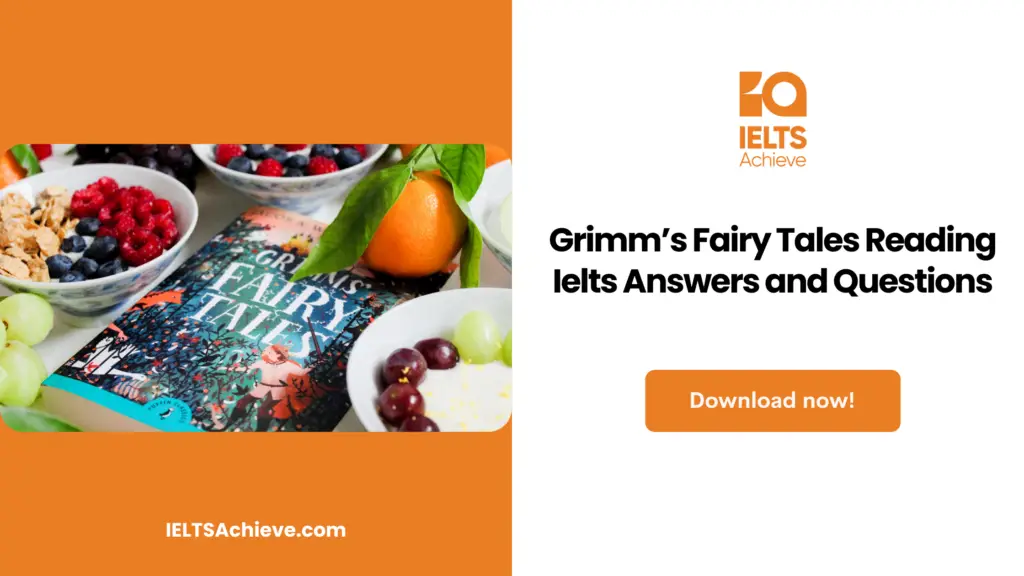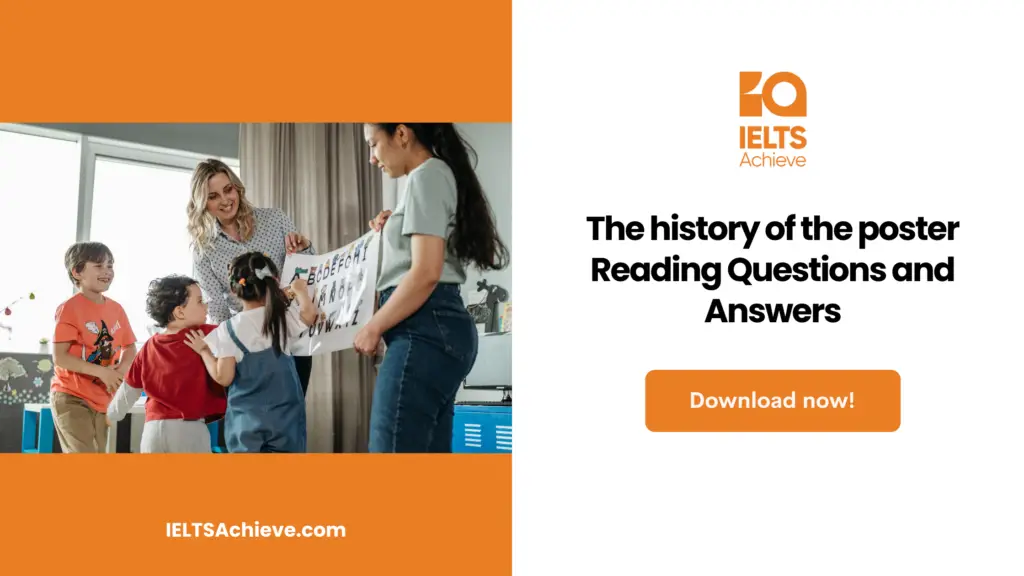The Blog post contains the following IELTS Reading Questions:
- IELTS reading yes no not given
- IELTS reading multiple choice questions
- IELTS reading matching sentence endings
Stay informed and prepared for success – Explore our comprehensive Reading Test Info page to get valuable insights, exam format details, and expert tips for mastering the IELTS Reading section.
Grimm’s Fairy Tales Reading Passage

Grimm’s Fairy Tales
Jacob and Wilhelm Grimm gave their story collection the title Children’s and Household Tales, and the very initial of its seven editions were released in Germany in 1812. Cinderella, Sleeping Beauty, Snow White, Little Red Riding Hood, Rapunzel, Rumpelstiltskin, Hansel and Gretel, and the Frog King are all listed in the table of contents like A-list fairy-tale stars. The 210 tales in the Grimm’s collection, which were primarily derived from oral narratives, comprise an unparalleled collection of fairy tales, animal fables, country farces, and religious allegories.
The modest Grimms would have been shocked by such enduring fame. The collection only sold a handful of hundred copies a year at first during their lifetimes in Germany.Early versions didn’t even have a child audience in mind. Scholarly citations took up almost as much space as the talcs themselves, and the brothers originally rejected to consider illustrations. Jacob and Wilhelm saw themselves as patriotic folklorists rather than kid-friendly entertainers. When they started their work, Napoleon’s French had just taken over Germany and were determined to repress local culture. The Brothers Grimm undertook the collection of fairy tales as young, workaholic scholars who were single and shared a small apartment with the intention of preserving Germany’s imperiled oral tradition.
Teachers, parents, and religious leaders, especially in the United States, condemned the Grimms’ collection for much of the 19th century because of its undeveloped, barbaric content. Adults who were offended protested the horrific punishments meted out to the stories’ villains. The evil stepmother in the original “Snow White” is made to dance in hot iron shoes until she passes out. The Grimms’ talcs are still avoided by some protective parents because of their reputation for violence.
Children’s and Household Tales gradually gained traction with the general public despite its occasionally rocky reception. The brothers had no idea that the publication of their work would take place at the same time as Europe’s children’s literature was experiencing great flowering. In order to appeal to a newly literate audience looking for moral nursery literature, English publishers took the lead and produced beautiful folktale collections and high-quality picture books like Jack and the Beanstalk. The Brothers Grimm began modifying and relaxing their tales, which had originally been earthy peasant fare, once they became aware of this new audience. The Grimms turned unmarried lovers into married couples, cruel mothers into evil stepmothers, and the intimate father into the devil.
The Grimms’ fairy tales have taken over children’s bedroom bookcases in the 20th century. The tales seem to come true: handsome lads and beautiful damsels defeat giants, witches, and wild animals with the aid of magic. They outsmart cruel, egotistical adults. The boy and girl will undoubtedly fall in love and marry. Parents continue to read because they agree with the finger-wagging morals drilled into the stories: keep your word, don’t approach strangers, put in the effort, and obey your parents. The Grimms claimed that the compilation served as “a manual of manners”.
About 40 people in total brought stories to the Grimms. A large number of storytellers visited the Grimms’ home in Kassel. Dorothea Viehmann, a widow who walked into town to sell produce from her garden, was especially welcomed by the brothers. Viehmann, the daughter of an innkeeper, had grown up hearing tales from travelers heading to Frankfurt.She had “Aschenputtel”—Cinderella—among her treasure. Their sister Charlotte’s friend, Marie Hassenpflug, was a well-educated, French-speaking woman in her 20s. Perrault’s influential 1697 book, Tales of My Mother Goose, which included elaborate versions of “Little Red Riding Hood,” “Snow White,” and “Sleeping Beauty,” among other stories, and Marie’s wonderful tales combined themes from the oral tradition. Numerous of these were adaptations of earlier Italian stories.
The question of how German Grimm tales are necessary in light of the fact that many of their sources can be found throughout Europe, the Middle East, and the Orient. Heinz Rolleke, a scholar, says it’s very. Teutonic characteristics include a love of the underdog, simplicity in the countryside, and creativity. The stories were also influenced by the rough texture of life in Germany during the Middle Ages when many of the tales entered the oral tradition. Similar to Hansel and Gretel, young children were frequently abandoned and neglected throughout Europe. As with the evil mother-in-law in “The Six Swans,” suspected witches were burned at the stake. Rolleke notes that “the cruelty in the stories was not the Grimm’s fantasy” but rather “it reflected the law-and-order system of the old times”.
The Grimms’ editorial imprint betrays the particular values of German bourgeois, Christian society in the 19th century. But that hasn’t stopped almost every culture and nation in the world from embracing the tales. What explains this widespread and enduring appeal? There are no specific descriptions of the clothes, the land, the forest, the castles, or the “universal style” of writing, as noted by Bernhard Lauer. According to Jack Zipes of the University of Minnesota, whose 1987 translation of the entire canon of fairy tales captures the rustic vigor of the original text, it makes the stories timeless and placeless. “The tales allow us to express ‘our utopian longings’,” he says. They demonstrate a desire for happiness that none of us fully understands but that we feel is attainable. We can empathize with the protagonists of the stories and imagine ourselves to be the masters and mistresses of our own fates.
The unconscious is exercised by fairy tales, according to psychoanalysts. The therapeutic value of the Grimms’ tales was famously emphasized by Bruno Bettelheim, who referred to fairy tales as “great comforters.” Children discover they can control their anxieties by facing their fears and phobias, which are represented by witches, heartless stepmothers, and ravenous wolves. The validity of Bettelheim’s theory is still hotly contested. However, the majority of young readers aren’t keen on using their unconsciousness. In fact, there are countless ways to enjoy the Grimm tales; something about them seems to reflect our own attitudes and interests as we read them. They are suitable for almost any time and any culture thanks to their flexibility of interpretation.
Unlock your full potential in the IELTS Reading section – Visit our IELTS Reading Practice Question Answer page now!
Recommended Questions:
Renewable Energy IELTS Reading Question with Answer
Grimm’s Fairytales IELTS Reading Questions
Questions 1-6
Do the following statements agree with the information given in Reading Passage?
In boxes 1-6 on your answer sheet, write
YES if the statement is true
NO if the statement is false
NOT GIVEN if the information is not given in the passage
- In England rather than Germany, the first edition of Grimm’s fairy tales sold more copies.
- The life of Dorothea Viehmann served as the inspiration for the Grimm brothers’ “Cinderella” story.
- For reasons that are different from those that children have, adults enjoy reading Grimm’s fairy tales.
- The Grimm brothers thought they would become well-known around the world.
- Grimm fairy tales are still viewed as inappropriate for children by some parents today.
- The Grimm brothers were compelled to operate covertly.
Want to excel in identifying the writer’s views and claims? Click here to explore our in-depth guide on how to accurately determine Yes, No, or Not Given in the IELTS Reading section.
Questions 7-9
Choose the correct letter, A, B, C, or D.
Write your answers in boxes 7-9 on your answer sheet.
7. What exactly did Marie Hassenpflug add to the Grimm Brothers’ stories?
A. She used her talent for languages to translate a well-known book for the brothers
B. She recited oral tales, which were based on classic Italian tales
C. She published storiesD. She talked with them about the stories
8. What modifications did the Grimm Brothers make in subsequent printings?
A. Less violence was featured in the stories’ plots
B. They discovered additional tales’ sources
C. The stories were condensed
D. They spoke more verbally
9. What changes in Europe are mentioned in paragraph D?
A. Children had access to schools
B. Excellent picture books were collected by many people
C. The population’s level of literacy increased
D. It became simpler to publish as printing technology advanced
Ready to improve your performance in Multiple Choice Questions (MCQs)? Click here to access our comprehensive guide on how to tackle MCQs effectively in the IELTS Reading section.
Questions 10-14
Complete the following summary of the paragraphs of Reading Passage, using NO MORE THAN TWO WORDS from the Reading Passage for each answer.
Write your answers in boxes 10-14 on your answer sheet.
10. According to Jack Zipes, the pursuit of happiness in the stories indicates that
11. According to Bruno Bettelheim, the therapeutic benefits of the stories make the fairy tales
12. Bernhard Lauer claimed that the Grimm Brothers’ writing style is universal since they
13. According to Heinz Rolleke, The Grimm’s Tales are “German” because
14. Heinz Rolleke claimed that the orphans in fairy tales
- Identify the real-life heroes
- narrate how straightforward life was in the German countryside
- help people believe in the power of nature
- assist kids in resolving their issues
- omit information about the social context of the characters
- reflect on the way of life at the time
- Show the inefficient system
- encourage people to think of themselves as capable of anything
Ready to sharpen your skills in Matching Sentence Endings? Click here to discover expert strategies and techniques for accurately matching sentence endings with the corresponding information in the IELTS Reading section.
Unlock your full potential in the IELTS Reading section – Visit our IELTS Reading Practice Question Answer page now!
Recommended Questions:
Renewable Energy IELTS Reading Question with Answer
Grimm’s Fairytales Reading Answers
1. Not given
2. No
3. Yes
4. No
5. Yes
6. Not given
7. B
8. A
9. C
10. H
11. D
12. E
13. B
14. F

We hope you found this post useful in helping you to study for the IELTS Test. If you have any questions please let us know in the comments below or on the Facebook page.
The best way to keep up to date with posts like this is to like us on Facebook, then follow us on Instagram and Pinterest. If you need help preparing for the IELTS Test, join the IELTS Achieve Academy and see how we can assist you to achieve your desired band score. We offer an essay correction service, mock exams and online courses.

